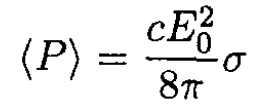
Electron and Radiation Reaction
 المؤلف:
Sidney B. Cahn Boris E. Nadgorny
المؤلف:
Sidney B. Cahn Boris E. Nadgorny
 المصدر:
A GUIDE TO PHYSICS PROBLEMS
المصدر:
A GUIDE TO PHYSICS PROBLEMS
 الجزء والصفحة:
part 1 , p 72
الجزء والصفحة:
part 1 , p 72
 9-8-2016
9-8-2016
 1401
1401
Electron and Radiation Reaction
The equation of motion for a particle of mass m and charge q in electric and magnetic fields E and B, including the radiation reaction force, is

a) Assuming that the radiative reaction term is very small compared to the Lorentz force and that v << c, find an approximate expression for the radiative reaction force in terms of E and B.
b) A plane electromagnetic wave propagates in the z direction. A free electron is initially at rest in this wave. Under the assumptions of (a), calculate the time-averaged radiative reaction force on the electron (magnitude and direction). What result would you obtain for a positron?
c) Rederive the reaction force by considering the momentum acquired by the electron in the process of forced emission of radiation. Use the Thomson cross section σ

SOLUTION
a) By assuming that v << c, we may write
 (1)
(1)
Differentiating (1) with respect to time, we obtain
 (2)
(2)
Substituting for  in (2) results in
in (2) results in

where we have disregarded terms first order in v/c. So
 (3)
(3)
b) Let the E field of the plane wave be polarized in the x direction, so that

The time averages of (3) are

so that
 (4)
(4)
The radiation reaction force varies with the fourth power of the charge, so a positron would yield the same result.
c) The average power scattered by the charge is
scattered by the charge is
 (5)
(5)
where σ is the total cross section. The average power is then
 (6)
(6)
The average incident momentum per unit time pi is given by
 (7)
(7)
where we used the relation ε = pc for radiation. Using the Thomson cross section for σ in (7) gives the reaction force

This is the same result as in (4).
 الاكثر قراءة في مواضيع اخرى
الاكثر قراءة في مواضيع اخرى
 اخر الاخبار
اخر الاخبار
اخبار العتبة العباسية المقدسة


